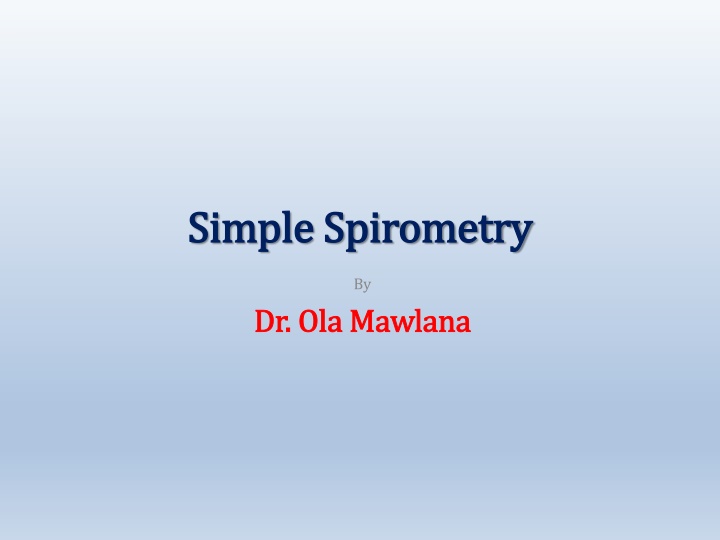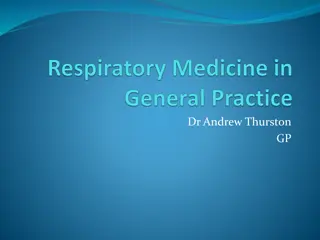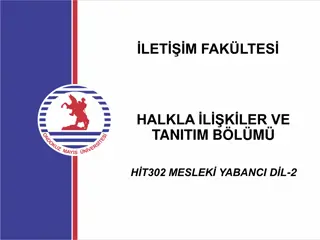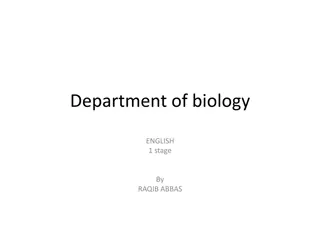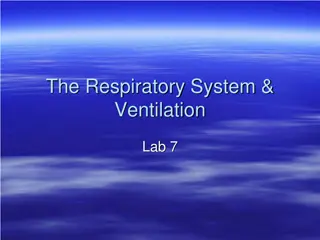Simple Spirometry
Pulmonary function test used to measure lung volumes and capacities. Learn about the bell-type spirometer, normal values, equipment needed, and the procedure involved. Understand how physiological and pathological factors can affect lung volumes and capacities.
Download Presentation

Please find below an Image/Link to download the presentation.
The content on the website is provided AS IS for your information and personal use only. It may not be sold, licensed, or shared on other websites without obtaining consent from the author.If you encounter any issues during the download, it is possible that the publisher has removed the file from their server.
You are allowed to download the files provided on this website for personal or commercial use, subject to the condition that they are used lawfully. All files are the property of their respective owners.
The content on the website is provided AS IS for your information and personal use only. It may not be sold, licensed, or shared on other websites without obtaining consent from the author.
E N D
Presentation Transcript
Simple Spirometry Simple Spirometry By Mawlana Dr. Ola Dr. Ola Mawlana
Objectives Objectives 1. Describe how a bell-type spirometer is used to measure lung volumes and capacities. 2. List and define the different lung volumes and capacities. 3. State the normal values of each lung volume and capacity. 4. Discuss the physiological and pathological factors that may affect the different lung volumes and capacities.
Spirometry Spirometry Is a pulmonary function test that measure lung volumes and capacities
Equipments Equipments Simple spirometer (many types are available, Bell- type spirometer or water-gauge spirometer) Nose clip. Disposable mouth piece.
Procedure Procedure 1. Insert the mouthpiece in the subject s mouth. 2. Place the nose clip on the subject s nose. 3. Ask the subject to take normal breaths through the mouthpiece for a short while. 4. After recording few normal breaths, ask the subject to take a deep forceful inspiration filling their lungs to their maximum ability, then exhale gently and follow it with few normal breaths. 5. Then ask the subject to expire quickly, forcibly and as completely as possible. Followed by an inhalation and a period of normal breathing. 6. Finally, ask the subject to take a deep forceful inspiration and to follow it immediately with maximum quick and forceful expiration. Once this is complete, ask the subject to breath normally for a short time. 7. The spirogram spirogram is recorded on a moving drum.
The subject breaths through a mouthpiece while a nose clip is placed on the nose to avoid air escaping through the nose. While breathing, air moves in and out of the spirometer chamber causing displacement in the pen attached to it surface. The moving pen draws the spirometry graph on the kymograph. The degree of displacement is proportional to the volume of air moving in and out of the lungs. With proper calibration, the volume of air moving in and out of the lungs can be calculated.
Lung Volumes & Capacities Lung Volumes & Capacities
Lung Volumes & Capacities Lung Volumes & Capacities 1 1. . TIDAL VOLUME (TV) TIDAL VOLUME (TV) - Volume of air inspired or expired during normal (quit) breathing - N = 500 500 ml ml or or 0.5 0.5 L L (male and female) 2 2. INSPIRATORY RESERVE VOLUME (IRV) . INSPIRATORY RESERVE VOLUME (IRV) - The extra volume of air that can be inspired by a maximal inspiratory effort after normal inspiration. - Average : 3000 3000 ml or ml or 3 3 L L - Male : 3.3 L Female : 1.9 L
3 3. EXPIRATORY RESERVE VOLUME (ERV) . EXPIRATORY RESERVE VOLUME (ERV) - The extra volume of air that can be expired by forceful expiration after the end of a normal tidal expiration. - Average : 1100 1100 ml or ml or 1.1 L 1.1 L - - Male : 1 L Female : 700 ml 4. RESIDUAL 4. RESIDUAL VOLUME (RV) - The volume of air remaining in the lungs after the most forceful expiration. - Average : 1.2 L 1.2 L ( RV & FRC can not be measured directly by Spirometry but measured by Hilum dilution method VOLUME (RV)
5 5. INSPIRATORY CAPACITY (IC) . INSPIRATORY CAPACITY (IC) - Volume of air inspired by a maximal inspiratory effort after normal expiration. - TV + IRV - Average : 3.5 3.5 L L - Male : 3.8 L Female 2.4 L 6. 6. FUNCTIONAL RESIDUAL CAPACITY (FRC) FUNCTIONAL RESIDUAL CAPACITY (FRC) - The amount of air that remains in the lungs at the end of normal expiration. - ERV + RV - Average : 2.3 2.3 L L
7 7. . VITAL VITAL CAPACITY CAPACITY (VC) - The volume of air that can be maximally expired after maximum inspiration.. = TV + IRV + ERV - Average : 4600 4600 ml ml or or 4 4. .6 6 L L - Male : 4.8 L Female : 3.1 L (VC) 8 8. . TOTAL TOTAL LUNG - Is the maximum volume to which the lungs can be expanded with the greatest with the greatest possible effort = =VC + RV - Average : 5800 5800 ml ml or or 5 5. .8 8 L L LUNG CAPACITY CAPACITY (TLC) (TLC)
Physiological Physiological factors factors affecting lung affecting lung volumes and volumes and capacities capacities 1. 1. Age Age - RV, FRC with age - VC with age 2. 2. Sex Sex - females have 20 25% less values in all pulmonary volume and capacities than males. 3. 3. Body Body size size - Obese : VC FRC because there's elastic recoil of the lungs 4 4. . Athletes Athletes - VC
Pathological Pathological conditions conditions affecting lung affecting lung volumes and volumes and capacities capacities Restrictive Restrictive Lung diseases Lung diseases ( e.g. Alveolar Fibrosis) - Reduce the compliance of the lungs --- compressed lung volumes - elastic recoil of the lungs --- VC, IRV, ERV, RV, TV --- breathing frequency
Obstructive Lung diseases Obstructive Lung diseases (e.g. Emphysema) - resistance to airflow --- TLC, FRC, RV, TV --- VC, ERV - elastic recoil of the alveoli
